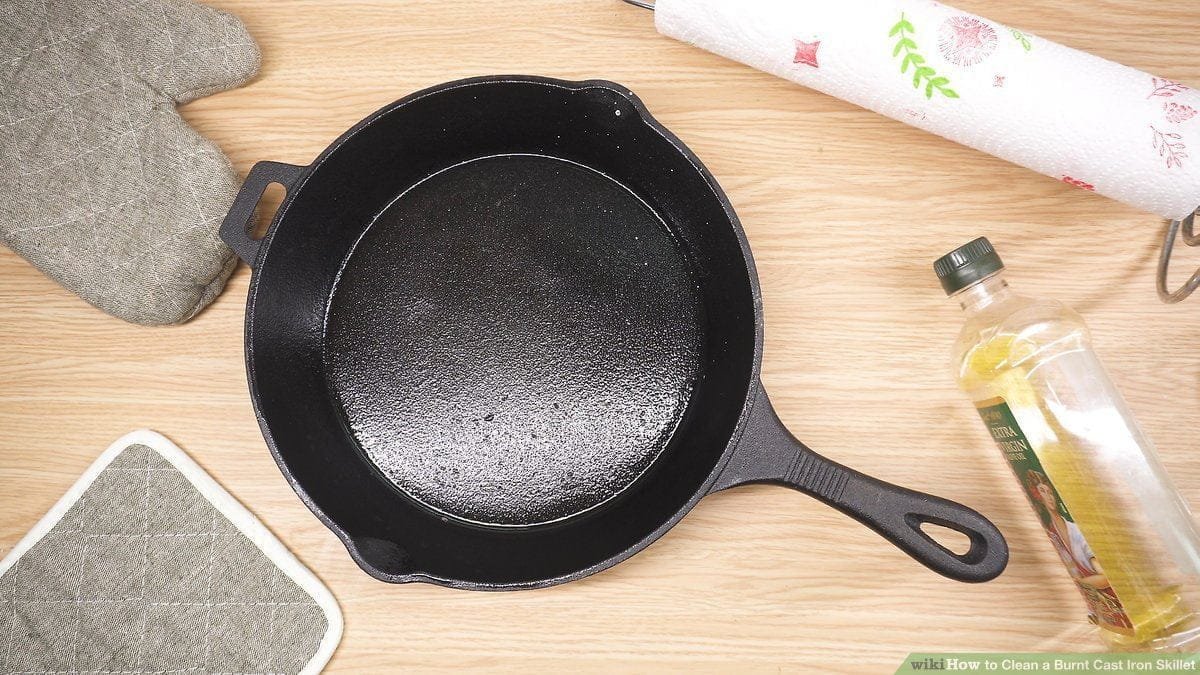
5 Steps to Clean Your Cast Iron Cookware
See Ya, Greasy & Burnt Food!
The Dark Knight of your kitchen, the forgotten child among your pans, the ugly but yet so powerful duckling that can become a fantastic swan. That’s the destiny of most cast iron pans: forgotten, feared, misunderstood. But what lays behind that dark steadiness is a softer and much more enjoyable side.

Cleaning a cast iron pan is one of many cooks’ worst perceived nightmare. In reality, it’s much easier than what you might think. Cleaning your cast iron pan is almost as easy as following your day-to-day shower routine. Let’s go through the main steps you can take to make your pan shine bright like a diamond:
- It’s bath time!
First of all, get your cast iron pan ready to be cleaned. If you are already a cast iron supporter, you might have used it at least once in the past few months or so. If not, get it back from the hidden storage areas of your kitchen cabinet or from the dusty hideouts of your garage. Even better than that, you can get a new pre-seasoned cast iron pan at Velosan. They’re well-known in this industry for their high-quality and eye-pleasing products. You can buy from them so many types of cast iron cookware that you didn’t even know they existed: cast iron pans, skillets, frying pans, casseroles, woks, Dutch ovens, and more. Now that your cast iron pan is ready, looking at you through eyes of love and hope, get prepared to wash it properly. Avoid using soap and steel wools. And never place it in the dishwasher. Never. While using soap and steel wools can ruin its layer of protection and affect its un-stickiness (but there are still remedies for this), placing it in the dishwasher is a cardinal sin punishable with a batch of bad luck. If you have already used your cast iron pan, remember to clean it when it’s still hot or warm. You can scrub off the stuck-on food with a combination of kosher salt and water, and by using a non-metal brush to preserve its non-stick surface.

- Scrub it off
If you want to clean your cast iron pan, that’s probably either because you recently bought a new one or because you already used yours. In both cases, you can still follow the instructions described in the previous point, with the only difference that you don’t need to add salt when scrubbing your new pre-seasoned cast iron pan. If you want to remove some bits of food, you can use the combination of salt and water we just mentioned and move your hand in circles of motion. You can keep rinsing the pan until water comes off clean. Then place it in the oven for a few minutes to dry off. We recommend leaving it there at 350° for 10 minutes or so. Be sure always to dry out your pan completely. Do not soak or leave it in the sink because it can easily rust. If it gets rusted, you can still recover it by applying a new layer of seasoning, but that would be more labor-intensive than just caring for it in the first place.

- Add that body cream
After placing the pan for a few minutes in the oven, all of its moisture should have dried out. Its surface will have the same texture of your skin after a whole day spent on the beach under the burning sun. Better to re-hydrate it. And that’s what it’s called “seasoning” your cast iron pan. That basically means that by adding a new layer of oil, preferably one without much flavors like vegetable oil or grapeseed oil, you are making your pan a great favor by preserving its non-sticky surface. It’s almost like applying body cream to your dry-as-hell pan. The next time you cook on it, food will not get burnt and stick on the pan in the blink of an eye. We don’t recommend using olive oil since it has a lower smoke point. That means that your pan will be more likely to get the flavor of the burnt oil and the same will then be true for your food. You can spread oil on the pan with your hands or by using a paper towel.
- Put that creamy oil for extra hydration
Once your pan has a brighter look, you can heat it in the oven at 500° for one hour. You can compare this extra step of care for your cast iron pan to adding a body oil or lotion to your dry skin. According to the American Academy of Dermatology, 56% of American women have sensitive dry skin, 40% of all women suffer from some degree of hair loss also because of dry hair, and even more folks end up having dry and rusty cast iron pans. Seasoning your pan follows the same basic principles. You add oil to ensure that the next time you cook, your pan will not become dry and your food burnt in a heartbeat. Seasoning your pan is important because oil has a chemical reaction at high temperatures. It will go from being an oil to becoming a polymer, and that means that your pan will have a stronger and more durable form of protection. To season your pan, put a little piece of foil underneath and then place it upside down. By doing this, you can be sure that all the exceeding oil will leave the pan. Then use a clean and dry cloth or paper towel to rub inside and outside the pan. You can buff it to remove any excess oil.

- Glossy and fab as hell
Those of you who struggle with dry skin know how well you feel after giving it extra hydration. Your skin looks more natural and healthier. Its tone is darker and more vivid than before. That’s similar to the results you can get with a well-seasoned cast iron pan. Seasoning your cast iron skillet should get rid of its blueish and silver shades, and transform it in a pan with a more matte black look. If you want to ensure higher results, you can add a little bit more oil to the already seasoned pan. You can use a cloth or paper towel to apply an extra light coat of vegetable oil or melted shortening both inside and outside the pan. You can now store in a dry place. Just don’t soak it in water or food leftovers, that would just welcome more rust to your pan. You definitely don’t want to eat food that tastes like you were licking jail windows. Besides that, there is a risk of consuming bacteria in the rust (tetanus). Thanks, but no thanks. Season well your cast iron pan and the next time you use it, you will be surprised by how easy it became to cook on it.
Besides being made of iron, cast iron pans are also highly karmic. You treat them well, they’ll treat you even better. They are not only a durable and highly versatile type of cookware, but they can also release extra flavor to your food the more you use them. Cast iron is a consistent heat conductor so it can stay hot for more extended periods of time compared to other types of pans. Properly seasoned and maintained cast iron pans can last a lifetime and be handed down for generations. That is why Velosan has been producing cast iron pans since 1896, and it’s still giving us this excellent type of cookware. Cast iron pans are like cheese and wine, they get better with time. Considering how great Velosan’s pans are now, we just can’t stop being excited to know what they’ll reserve for us in the future.






